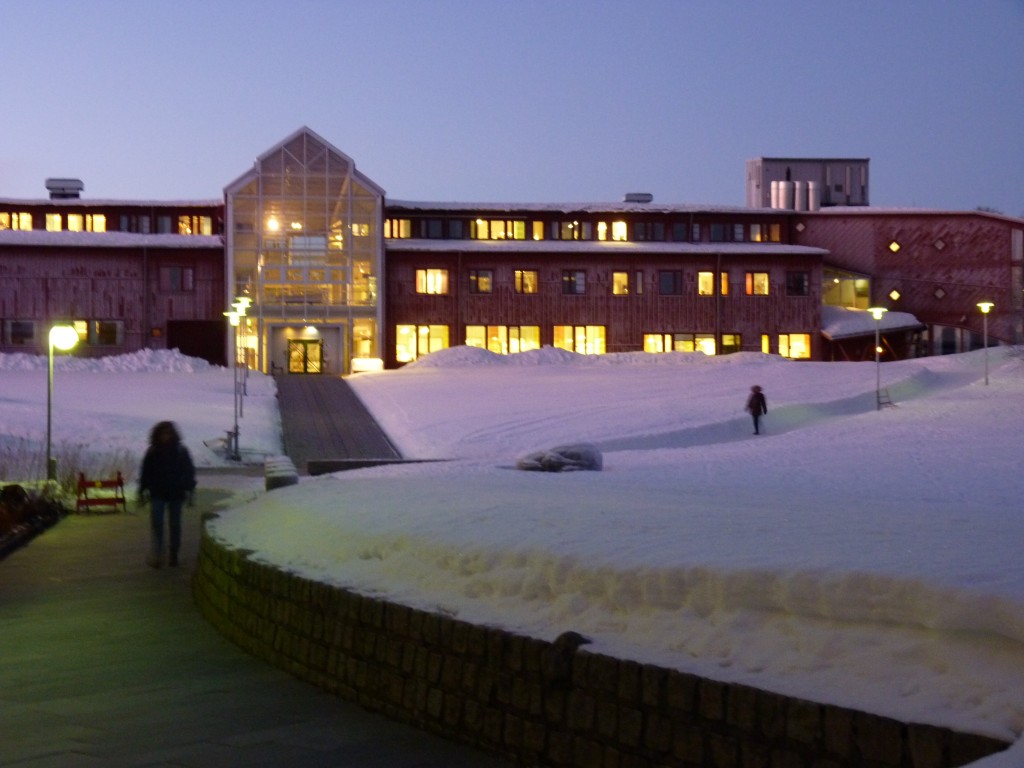Search Results for Tag: UiT
Snow delays? In Norway?
Norway is one place that generally has no problem with a bit of snow, but my flight from Oslo to Longyearben on Svalbard is indeed delayed because of snow. There seems to be a queue at the de-icing stand. I am hoping there will be no problems catching the next little plane up to Ny Alesund. But as it is a fairly special flight, I am hoping the pilot and my Polar Night colleagues already in Longyearben will wait for me.
As I struggled to get out of bed early on a cold, snowy morning, I imagined what it must be like to live in the High Arctic and have a few months without any light at all. Tough going! But there is also something absolutely beautiful about snow in moonlight and starlight.
I am looking forward to seeing Ny Alesund again, although I know it will be very different in the dark. In summer, of course, it is light all year round. The weather seems to be fairly changeable. A colleague in Tromso (where I shall be heading after the scientific boat expedition) tells me there are some areas with no snow cover and others close by covered by snow drifts. “Pack for everything”, he said, and be prepared for a VERY cold spell on the horizon.
A fellow passenger told me he had been evacuated from a ship at Trondheim, because of gale force winds, force 12. So I am wondering what conditions will be like for our ship, the RV Helmer Hanssen, when it leaves Ny Alesund later today.
Meanwhile, when I left Germany yesterday, I saw hazel bushes in bloom. I reminded myself this is January. But of course it comes after the warmest year on record. The climate is changing – and I am headed for the region most affected on the whole planet, warming at around twice the average speed. I’ll keep you posted.
Unlocking secrets of the polar night
During visits to Arctic research sites in summer, I have experienced first-hand the energy and inspiration that comes from around-the-clock light. Who wants to go to sleep with the sun shining at midnight and land, sea and sky awash with changing waves of blue, grey, pink and gold Arctic light?
But what happens up north during the dark winter months? It is hardly surprising that summer is the season when scientists collect most of their data. There is a huge lack of information about Arctic ecosystems during the long polar night.
This is especially the case when it comes to marine ecosystems. Experts at UiT, the Arctic University of Norway, based in Tromsö, are trying hard to make up for that. UiT is the northernmost university of the world. It says its location on the edge of the Arctic defines its mission: to research into the region, which is of increasing global importance. That includes the impacts of climate change, the exploitation of Arctic resources and environmental threats. And that doesn’t stop with the onset of winter.
Investigating polar nightlife
Polar Night Biology is one of UiT’s special research focuses. Until recently, the prevailing view was that the polar night was devoid of biological activity. But this was based on a lack of data and research, say the Tromsö experts. Extreme conditions, with darkness, cold and widespread ice make access much harder and riskier in winter. Some newer research expeditions into the polar night have produced results which challenge our understanding of Arctic marine organisms and ecosystems, say Stig Falk-Petersen, Professor of Arctic and Marine Biology at UiT, and his colleagues. There is plenty of biological activity in the far north of the planet all the year round. We need to understand how the Arctic ecosystem functions in winter if we are to understand the impacts of climate change on it. “Polar-night ecology of Arctic marine systems is a new area of research with the potential for radically altering our fundamental perception of the current state of the Arctic marine ecosystem, mechanisms governing ecosystems processes, and how climate change in the region will affect ecosystem structure and function”, says the UiT website.
So how are warmer air and ocean temperatures and the decline of Arctic sea ice affecting organisms that normally live under it, or are dependent on it in some way or other, at this time of year? And what impact will that have on the whole food web in which they play a role?
Next week, Falk-Petersen will be heading a scientific boat expedition into the Arctic waters off northern Svalbard. Ahead of this year’s annual Arctic Frontiers conference in Tromsö, I have been invited to join him and his researchers, as they try to find out more about Arctic marine organisms and ecosystems during the polar night.
I hope you’ll join us too, here on the Ice Blog for daily updates. Watch this space! We will be sailing on the university’s research vessel, the RV Helmer Hanssen. It’s currently heading across from Tromsö to Spitsbergen, where we’ll be joining the crew. You can track the ship’s progress here.




















Feedback